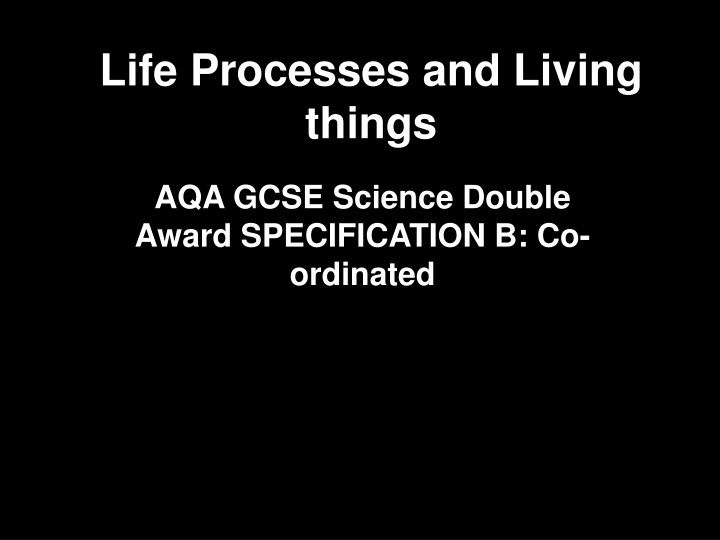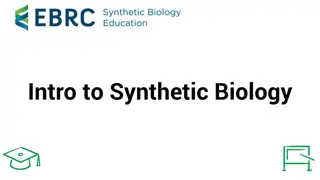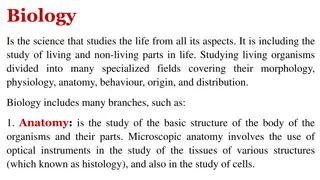GCSE Biology Course Overview
This GCSE Biology course covers essential topics such as cell activity, nutrition, respiration, genetics, evolution, and more. With a focus on life processes and living organisms, students will explore the intricate workings of plant and animal cells, understand fundamental biological processes, and delve into the fascinating world of genetics and inheritance. Engaging modules, detailed lesson objectives, and core concepts are presented to aid students in grasping key biological principles effectively.
Download Presentation

Please find below an Image/Link to download the presentation.
The content on the website is provided AS IS for your information and personal use only. It may not be sold, licensed, or shared on other websites without obtaining consent from the author.If you encounter any issues during the download, it is possible that the publisher has removed the file from their server.
You are allowed to download the files provided on this website for personal or commercial use, subject to the condition that they are used lawfully. All files are the property of their respective owners.
The content on the website is provided AS IS for your information and personal use only. It may not be sold, licensed, or shared on other websites without obtaining consent from the author.
E N D
Presentation Transcript
Life Processes and Living things AQA GCSE Science Double Award SPECIFICATION B: Co- ordinated
About Your Course This is the first lesson of your Year 10 GCSE Biology Course. Science is worth two GCSEs from A*A*-DD at Higher level and from CC-GG at Foundation Level. We will discuss your tier of entry after the Y11 Mock exam. Biology contributes 26 2/3% towards your final GCSE grade 20% of your final grade is an Coursework Investigatiom
Modules you will study: [Y10] 10.1: Cell Activity 10.2: Transport across Boundaries 10.3 Cell Division (Year 11) 10.4 Nutrition 10.5 Circulation 10.6 Breathing 10.7 Respiration 10.8 Nervous system 10.9 Homeostasis 10.11 Disease 10.13 Drugs 10.14 Plant Nutrition 10.15 Transport and Water Relations
Modules you will study [Y11] 10.16 Variation 10.17 Genetics and DNA 10.18 Controlling Inheritance 10.19 Evolution 10.20 Adoption and Competition 10.21 Human impact on the environment 10.22 Energy and Nutrient transfer 10.23 Nutrient Cycles
Lesson objectives To recap the 7 Life Processes To be able to start 10.1: Plant and Animal Cells To understand the differences between plant and animals in terms of structure To recall the functions of the different parts of plants and animal cells To be able to show this in a visual form. HT: To understand the term Mitochondria
Life Processes These can be remembered using the Mnemonic MRS NERG or MES GREN Movement- the ability to move from one place to another Respiration a chemical process that takes place in every living cell Sensitivity the ability to respond to your environment Nutrition turning food into energy Excretion getting rid of waste products Reproduction producing offspring Growth- becoming larger in size
Features of Cells There are 3 main parts that are common to both plants and Animal Cells. Organise these into the headings: Plant and Animal Cells and plant cells only. Plant Cells Plant and Animal Cells Has a Cell Wall Has a Nucleus Has a Cell Membrane Has a Cytoplasm Has Cholloroplasts Has a Vacule RE-ARRANGE SO THEY ARE IN THE CORRECT COLOMNS
What are the functions of the Cell? Cell Wall is made of cellulose it strengthens and supports the cell Chloroplasts, which contain Chlorophyll, absorb light energy to make food through Photosynthesis. A Vacuole is filled with cell sap [a sugar and water solution] and it provides rigid support. this is for PLANTS ONLY
What are the functions of the cell? Cell Membrane controls what goes in and out of the cell Cytoplasm is where all the reactions take place A Nucleus is like the brain of the cell and controls the activity of the cell. THIS APPLIES TO BOTH PLANT AND ANIMAL CELLS This applies to BOTH types of Cell
What do they look like? PLANT ANIAMAL
Additional Material for HT HIGHER TIER Chemical Reactions are controlled by enzymes. The cytoplasm contains special structures called Mitochondria, which is where most of the energy is released during respiration.
Homework This question is taken from a past GCSE paper. Give the function of these parts of a plant cell. Chloroplast Cell wall Vacuole
Cells, Tissues and Organs A group of similar cells is called a A group of afferent tissues form a A group of organs working together form a Or a whole organism Key Words: Organ Organism Tissues Organ System
Palisade Cells Palisade Cells are designed for Photosynthesis Tall shape means a lot of surface area exposed down the side for absorbing C02 Good chance of light hitting the chloroplast before it reaches the bottom of the cell.
Specialist Cells Specialist Cells have a particular functions that help them to carry out their job efficiently. You might be asked how a particular type of cell is adapted to the job it does. You will therefore need to make notes on the following pieces of information.
Sperm Cell 1) The sperm cell - designed to fertilise eggs A sperm cell is very small and has a little tail which provides movement so it can swim and find an egg to fertilise Its head contains enzymes (in the vacuole) which allow it to digest its way through an egg membrane so the two nuclei can join It contains half the number of chromosomes in the nucleus - these carry genetic information from the father, which will be passed on to the offspring
Cilia Cell 4) The cilia cell - designed to stop lung damage Cilia cells line all the air passages in your lungs They have tiny hairs, which filter the air as it blows through The hairs sweep mucus (snot) with trapped dust and bacteria up to the back of the throat where it is swallowed
Egg Cell 2) The ovum (egg) cell - designed to be fertilised An ovum is large and bulky because no active movement is needed - it just sits and waits for the sperm to find it It contains yolk (in the cytoplasm) which provides a large food store needed for the developing young organism once it's fertilised It contains half the number of chromosomes, which carry genetic information from the mother - this will be passed on to the offspring
The root hair Cell 5) The root hair cell - designed for absorbing The long hair cell increases the surface area of the root, which helps absorption of water and minerals It has a really thin cell wall, which makes it easier for minerals to pass across into the root itself
Red Blood Cells Doughnut shape to allow maximum O2 absorbed by the haemoglobin they contain. The function is similar the the Palisade Cells . They are doughnut shaped rather than tall to allow smooth passage through the capillaries They are so packed with Haemoglobin that they have no room for a Nucleus
White Blood Cells Are specialised because they help protect us against disease. They do this in two ways: By engulfing the bacteria By producing Antibodies, which recognise a particular type of illness the first time you have it, so when it appears again, you will not become ill. This does not, however, work with viruses.
Homework Explain how the Red Blood Cell [or a cell of your choice] is adapted to the job it carries out. In order to gain full marks, you should express your ideas using the correct scientific works and use good English (3 marks))
This powerpoint was kindly donated to www.worldofteaching.com http://www.worldofteaching.com is home to over a thousand powerpoints submitted by teachers. This is a completely free site and requires no registration. Please visit and I hope it will help in your teaching.























